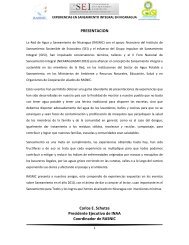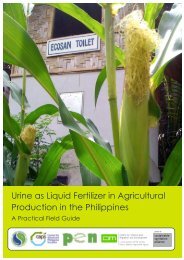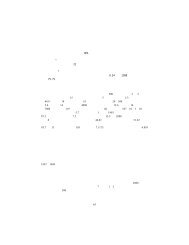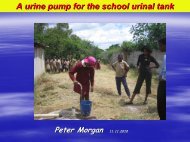Open Planning of Sanitation Systems
Open Planning of Sanitation Systems
Open Planning of Sanitation Systems
You also want an ePaper? Increase the reach of your titles
YUMPU automatically turns print PDFs into web optimized ePapers that Google loves.
Elisabeth Kvarnström and Ebba af Petersensstudied and discussed in such detail that that the community understands why they are feasibleand adequate. The alternatives that do not fulfil the ToR are abandoned.CASE STUDY: Possible sanitation system solutions identified for Vadsbro village1. Primary treatment, storage and forest irrigation2. Stabilization ponds with chemical (Ca(OH) 2precipitation3. Primary treatment, trickling filter and bi<strong>of</strong>ilter ditch4. Primary treatment, trickling filter and crop/wetland rotation5. Primary treatment, sand filter and bi<strong>of</strong>ilter ditch/wetland6. Package treatment plant (sequencing batch reactor, SBR), including nitrification followed by abi<strong>of</strong>ilter ditch or wetland.Four different wastewater systems with decentralized solutions were also proposed to thestakeholders but were not accepted. The reason for this was the fact that the centralized systemalready existed where the sewerage system had been subject to a recent renovation.The matrix scoring exercise is available in Appendix 4.STEP 5: CHOICE OF THE MOST APPROPRIATE SOLUTIONStep 5 has similarities with the HCES approach STEPs 6-8 (Schertenleib et al., 2004). The<strong>Open</strong> <strong>Planning</strong> <strong>of</strong> <strong>Sanitation</strong> <strong>Systems</strong> Step 4 resulted in at least three sanitation alternativesthat comply to the ToR. The final step is to evaluate and compare these alternatives, using, forexample, a PHAST tool called ‘<strong>Sanitation</strong> Options’ and the matrix scoring exercise mentionedabove. The final choice should be made by the future users <strong>of</strong> the proposed sanitation system.CASE STUDY: Final choice <strong>of</strong> sanitation system for Vadsbro villageThe stakeholders finally settled for alternative 3 above, after having discussed the consequences<strong>of</strong> each alternative in relation to the ToR with the sanitation expert. Presentations with simplesketches were used showing how each alternative worked technically and also its complianceand consequences according to the ToR. The use <strong>of</strong> ToR made the comparison between thealternatives quite easy. Considerations <strong>of</strong> costs and risks were decisive for the stakeholders’decision. Alternative 6, the package treatment plant, was the initially favoured alternative.However, the bi<strong>of</strong>ilter ditch in alternative 3 was seen, after going through the alternatives inrelation to the ToR, as both significantly less expensive and more efficient for pollutant reductionand nutrient recycling (Ridderstolpe, 1999).DiscussionBy looking at several sanitation alternatives, the future users have the opportunity to select, ina participatory process, the system that best matches their preferences and that is affordable.Municipalities, private companies and NGOs will be less likely to show monopolistic behaviourand to impose their solutions on the future users. Merits, risks and costs <strong>of</strong> a sanitation systemwill be presented in an open process, and an informed choice can be made by future users andother stakeholder groups. As a result, they will be confident that they have selected the solutionmost appropriate for their situation and specific needs. This in turn will increase the likelihood<strong>of</strong> proper system operation and maintenance.12



![Project Document [PDF: 2.31 MB] - EcoSanRes](https://img.yumpu.com/51279385/1/184x260/project-document-pdf-231-mb-ecosanres.jpg?quality=85)












![Latrines à compost [high-resolution colour PDF: 12.3MB] - EcoSanRes](https://img.yumpu.com/31726141/1/185x260/latrines-a-compost-high-resolution-colour-pdf-123mb-ecosanres.jpg?quality=85)